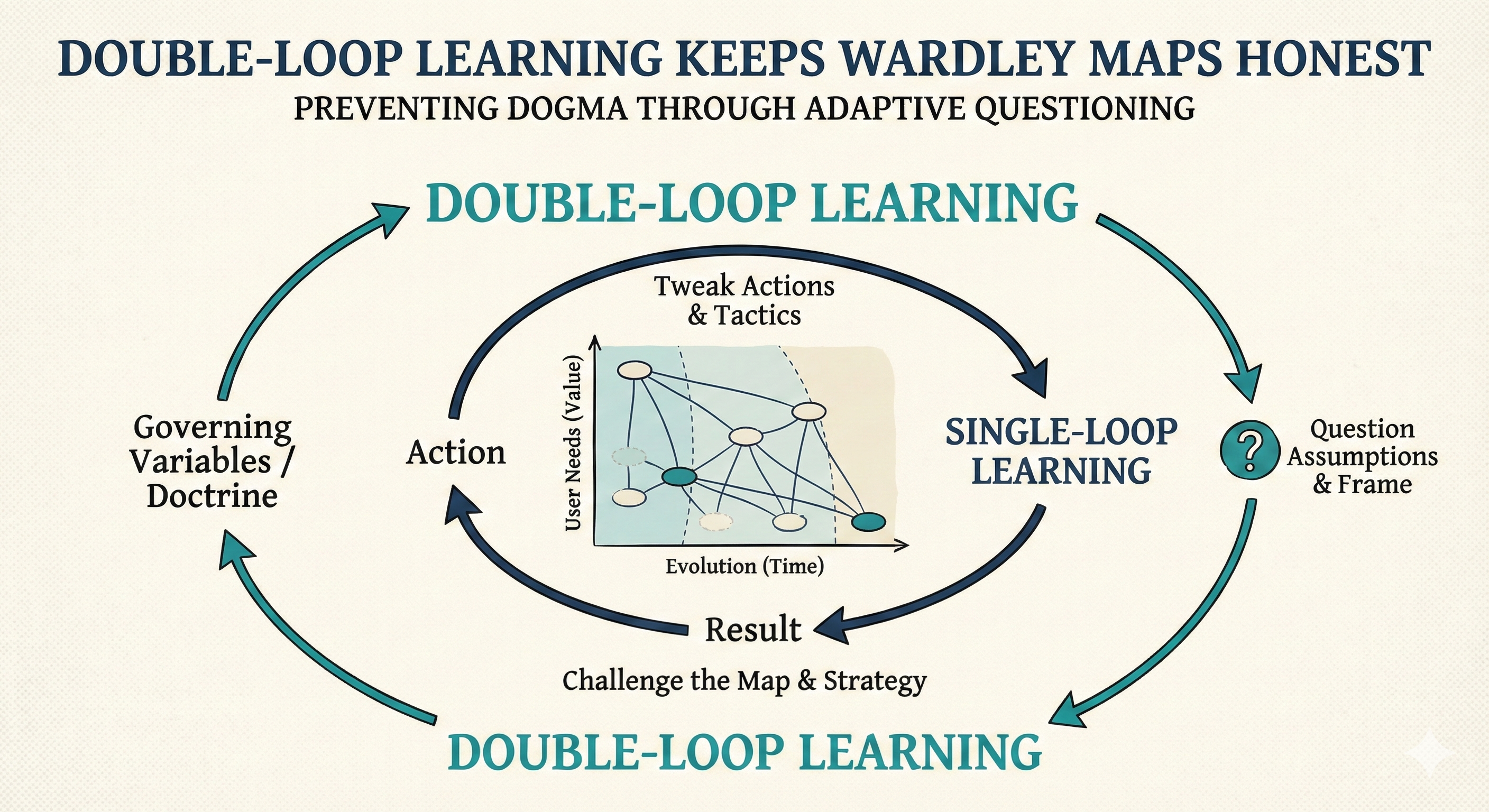Double-Loop Learning Keeps Wardley Maps Honest
In our last post, we explored the cybernetic fate of organisations and the difficult choices they face when dealing with complexity. We saw how important it is to match the complexity of the environment with the complexity of the organisation's response. But how can we be sure that our understanding of the environment is accurate and that our responses are the right ones?
Wardley Maps can fool experienced teams into mistaking the map for the territory. When the landscape is drawn clearly, leaders can get caught up in making small tweaks instead of questioning the entire frame. This is where Double-loop learning—a concept from Chris Argyris and Donald Schön about questioning our underlying assumptions—brings back a dose of humility. It forces you to ask not only, "Did we place the components correctly?" but also, "Are we even mapping the right thing?"

How this post fits the series
- Provides the reflective mechanism that prevents the AI leadership playbook from ossifying into dogma.
- Keeps continuous map governance honest by challenging the inputs and the plays, not just the telemetry.
- Reinforces AI-accelerated user needs by ensuring that research updates mental models, not just the backlog.
The Precision Trap of Wardley Mapping
The strength of Wardley Mapping is its shared visual language of value chains, user needs, and evolution. But this clarity hides a trap: a component's position on a map can look like a fact, even when the team has just guessed based on limited data. Over time, a map can cement a particular worldview. Reviews start to focus on polishing the details of the map rather than challenging whether it still accurately describes the landscape. Without a deliberate effort to counter this, the practice can slide into 'single-loop learning'—simply optimising tactics within a frame that no one questions.
Double-Loop Learning: The Map Around the Map
Double-loop learning adds a reflective step to the day-to-day routine of mapping. Instead of just correcting actions ('single-loop'), the team questions the assumptions and norms that are built into the map itself. It asks whether the chosen user needs are still valid, whether the evolution axis is still the right lens to use, and whether our own doctrines are biasing how we draw the components. This 'meta-loop' treats every map as a hypothesis, not a statement of fact. By bringing hidden assumptions to the surface, it keeps the map fluid and the team adaptive.
Designing a Double-Loop Routine for Mapping
Leaders can build a simple routine that wraps around every mapping session:
- State your assumptions upfront. Before drawing, clearly state the assumptions you're making: the timeframe, the key user, and why you've chosen evolution as the main axis. Document these in the map's notes.
- Run a "frame check" review. After mapping, hold a ten-minute review that asks: What did we treat as a certainty? Which constraints did we assume rather than prove with evidence? How might a different axis—like power dynamics, trust, or volatility—change our interpretation?
- Invite different perspectives. Rotate who facilitates the mapping session or include observers from other teams. Ask them to redraw a part of the map or to highlight areas of uncertainty. Fresh eyes can expose where you've mistaken your model for reality.
- Track how assumptions change over time. Compare different versions of the same map. If a component's placement stays the same despite changes in the environment, treat that as a signal to revisit your doctrine or your definition of the user.
Signs That Your Meta-Loop Is Working
A functioning double-loop shows up in behaviour more than in the maps themselves:
- Maps show uncertainty explicitly. Components on the map include notes about confidence levels or missing data, instead of claiming a false precision.
- Strategy choices change. When the frame shifts, you see different strategic plays being considered—perhaps you shelve a plan to commoditise a component because you realise your definition of the user was wrong.
- Doctrine evolves. Principles like Focus on User Needs or Use a Common Language are revisited, clarified, or even retired based on what the meta-loop reveals.
- Teams ask bigger questions. Conversations expand from "Where should we move this component?" to "What signals would prove this entire value chain is obsolete?"
Questions to Keep Your Maps Honest
Use these prompts to reinforce the double-loop:
- Assumptions: Which of our beliefs about user needs, scope, or evolution went untested in this map?
- Evidence: What data would prove that our current placement of critical components is wrong?
- Perspective: Who outside this team would map the same landscape differently, and why?
- Impact: If this map were used to guide a major investment, what risks would come from our framing being wrong?
- Practice: How is the act of mapping itself changing the system we're observing? Are we changing behaviours just by drawing them?
Double-loop learning doesn't make mapping slower; it keeps the practice honest. By continuously challenging the frame, leaders can avoid turning Wardley Maps into dogma and instead keep them as living guides for navigating the competitive landscape.
References
- Argyris, C. (1977). Double loop learning in organizations. Harvard Business Review, 55(5), 115–125. https://hbr.org/1977/09/double-loop-learning-in-organizations
- Argyris, C., & Schön, D. A. (1996). Organizational learning II: Theory, method, and practice. Addison-Wesley. https://mitpress.mit.edu/9780201629836/organizational-learning-ii/
